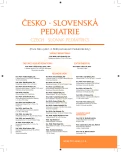Mathematical modeling of infectious childhood diseases
Authors:
J. Zibolenová 1; D. Ševčovič 2; T. Baška 1; D. Rošková 1; E. Malobická 1; V. Szabóová 1; V. Švihrová 1; H. Hudečková 1
Authors‘ workplace:
Ústav verejného zdravotníctva, Jesseniova lekárska fakulta v Martine, Univerzita Komenského v Bratislave, vedúca prof. MUDr. H. Hudečková, PhD., MPH
1; Katedra aplikovanej matematiky a štatistiky, Fakulta matematiky, fyziky a informatiky, Univerzita Komenského, Bratislava, vedúci prof. RNDr. D. Ševčovič, CSc.
2
Published in:
Čes-slov Pediat 2015; 70 (4): 210-214.
Category:
Original Papers
Overview
The article deals with mathematical modeling in epidemiology and analyses principles of deterministic SIR model (susceptible – infected – resistant) which is used particularly to describe spread of infectious childhood diseases and represents a concept of herd immunity in association with a basic reproduction number and vaccination.
Using the open SIR model, we can explain basic features of spread of diseases causing permanent immunity such as mumps, varicella, measles and rubella.
Development of proportions of susceptible, infected and resistant individuals in non-vaccinated population shows a character of damped oscillations. Oscillations of proportions of individual groups are mutually interconnected. As an effect of a birth rate, the number of susceptible individuals increases up to a critical level, when the epidemic outbreak emerges followed by increase of proportion of infected individuals. This leads to a dramatic decrease of proportion of susceptible individuals resulting in deceleration of spread of the infection.
The vaccination substantially influences occurrence of the disease. If the vaccination rate is below of a threshold of the herd immunity, spread of infection is limited. However, mean values of proportions of susceptible individuals are not significantly changed. If the vaccination rate exceeds the level needed for the herd immunity, according to the model, spread of the infection is halted and the proportion of susceptible persons continuously decreases.
In Slovakia, within the above mentioned diseases, mass vaccination against measles, rubella and mumps is provided. Situation regarding occurrence of these disease is relatively favorable and except minor local outbreaks of mumps they almost do not occur in Slovakia. However, we should take into account possible changes of epidemiological situation, particularly considering increase of antivaccination activities. As seen in our contribution, accumulation of susceptible individuals above certain level constitutes a risk of reemerging of epidemic outbreaks.
Key words:
mathematical modeling, infectious childhood diseases, basic reproduction number, vaccination
Sources
1. Keeling MJ, Rohani P. Modelling Infectiouse Disease in Humans and Animals. Princeton: Princeton University Press, 2008.
2. Kosina P, Krausová J, Kračmarová R, et al. Komplikace varicely u detí. Čes-slov Pediat 2009; 64 (7–8): 331–336.
3. Dražan D. Varicella. Pediatrie prax 2008; 2: 101–103.
4. Bakoss P. Epidemiológia. Bratislava: Univerzita Komenského, 2005.
5. Hudečková H, Švihrová V. Očkovanie. Martin: Osveta, 2013.
6. Vynnycky E, White R. An Introduction to Infectious Disease Modelling. New York: Oxford University Press, 2010.
7. Kermack WO, McKendrick AG. A contribution to the mathematical theory of epidemics. Proc Roy Soc Lond A 1927; 115 (772): 700–721.
8. Hethcote HW. The basic epidemiology models – models, expressions, for R0, parameter estimation and applications. Mathematical understanding of infectious disease dynamics, 2008. Citácia [26. 2. 2015, http://www.worldscientific.com/doi/suppl/10.1142/7020/suppl_file/7020_chap01.pdf].
9. Mishra MN, Vinay K. Mathematical model of diseases for susceptible infected recovery. VSRD Technical and Non-technical Journal 2012; 3 (3): 84–95.
10. Mishra S, Fisman DN, Boily MC. The ABC of terms used in mathematical models of infectious diseases. J Epidemiol Community Health 2010; 65 (1): 87–94.
11. Fine PEM. Herd immunity: history, theory, practice. Epidemiologic Reviews 1993; 15 (2): 265–302.
12. Hollingsworth TD. Controlling infectious disease outbreaks: Lessons from mathematical modelling. Journal Public Health Policy 2009; 7: 328–341.
13. Kim SY, Goldie SJ. Cost-effectiveness analyses of vaccination programmes. Pharmacoeconomics 2008; 26 (3): 191–215.
14. Ozawa S, Mirelman A, Stack ML, et al. Cost-effectiveness and economic benefits of vaccines in low- and middle-income countries: A systematic review. Vaccine 2012; 31: 96–108.
15. Hoek AJ, Melegaro A, Gay N, et al. The cost-effectiveness of varicella and combined varicella and herpes zoster vaccination programmes in the United Kingdom. Vaccine 2012; 30 (6): 1225–1234.
16. Banz K, Wagenpfeil S, Neiss A, et al. The cost-effectiveness of routine childhood varicella vaccination in Germany. Vaccine 2003; 21: 1256–1267.
17. Gayman J. A cost-effectiveness model for analyzing two varicella vaccination strategies. American Journal Health-System Pharmacy 1998; 55 (Suppl 4): 54–58.
18. Hudečková H, Straka Š, Rusňáková Š. Epidemiological features and economic evaluation of a potential chickenpox vaccination strategy in Slovak Republic. Central European Journal Public Health 2000; 8 (4): 227–228.
19. Brisson M, Edmunds WJ, Gay NJ, et al. Modelling the impact of immunization on the epidemiology of varicella zoster virus. Epidemiol Infect 2000; 125: 651–669.
20. Gay N. Modeling measles, mumps, and rubella: implications for the design of vaccination programs. Infection Control Hospital Epidemiology 1998; 19: 570–573.
21. Chen SC, Chang CF, Jou LJ, et al. Modelling vaccination programmes against measles in Taiwan. Epidemiology Infection 2007; 135: 775–786.
22. Gajdošíková A, Krištúfková Z, Špániková M. Postoje všeobecných lekárov pre deti a pre dorast k očkovaniu a trend odmietania očkovania. In: Hudečková H, Švihrová V, Baška T. Aktuálne problémy verejného zdravotníctva vo výskume a praxi. Martin: Jesseniova lekárska fakulta Univerzity Komenského v Martine, 2013: 64–69.
Labels
Neonatology Paediatrics General practitioner for children and adolescentsArticle was published in
Czech-Slovak Pediatrics

2015 Issue 4
Most read in this issue
- Enzyme replacement therapy in lysosomal storage diseases
- Diagnostic and treatment pitfalls of pheochromocytoma in children
- Gastrointestinal adverse effects of methotrexate in patients with juvenile idiopathic arthritis – are they properly assessed?
- Possibilities of reducing pain in children on the psychosocial level
